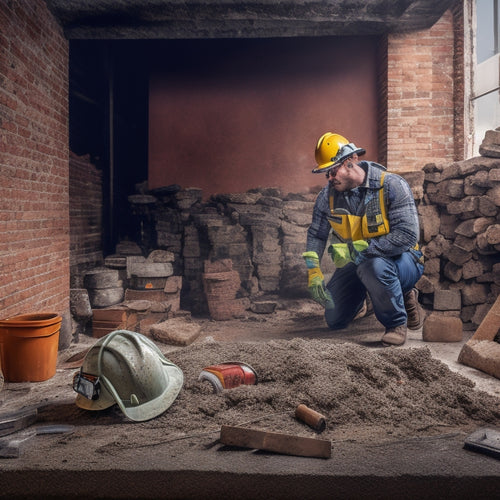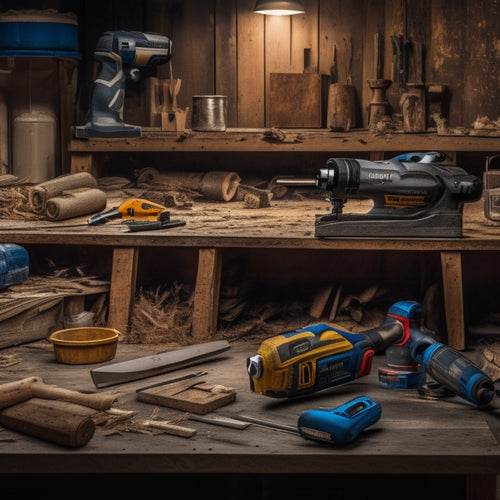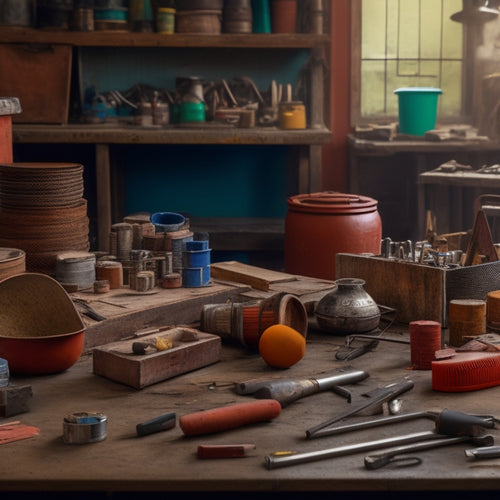
Must-Have Tools for Tamping Concrete During Renovation
Share
When renovating concrete surfaces, you need reliable tamping tools that deliver accurate, efficient, and durable performance to guarantee a flawless finish and prevent costly rework. To get the job done right, look for tools with durable, heavy-duty handles made of high-quality materials like steel or aluminum, and ergonomic grip designs that reduce fatigue and accidents. Consider power tamping tools for high-torque output and reliability, or vibratory plate compactors for granular soils and crushed aggregates. As you explore the world of tamping tools, you'll discover the importance of features like built-in levels, textured surfaces, and cushioned grips, and uncover the secrets to achieving professional-grade results.
Key Takeaways
• A durable hand tamper with an ergonomic grip is essential for efficient and accurate compaction in confined spaces.
• A power tamping tool, such as an electric tamper, offers high-torque output and reliability for faster compaction.
• A vibratory plate compactor is ideal for compacting granular soils and crushed aggregates, enhancing surface finish and stability.
• A tamping rod is necessary for compacting and leveling concrete, ensuring even surfaces and preventing defects.
• Regular maintenance and cleaning of tamping tools, including proper storage and cleaning, are crucial for extending their lifespan and performance.
Essential Tamping Tool Features
What features should you look for in a tamping tool to guarantee it effectively compacts and flattens concrete, while also withstanding the rigors of heavy use?
When selecting a tamping tool, prioritize features that promote both performance and safety. Look for a tool with a durable, heavy-duty handle that can withstand the force and vibration of compacting concrete. A comfortable, ergonomic grip is also vital to reduce fatigue and prevent accidents. The tamping plate should be made of high-quality, wear-resistant materials to maintain its shape and effectiveness over time.
In addition, consider the benefits of a tamping tool with adjustable handle lengths and angles to accommodate different user preferences and working conditions. This feature can help prevent strain and injury, promoting tamping tool safety.
Moreover, opt for a tool with a built-in level or spirit level to guarantee accurate, even compaction. By choosing a tamping tool with these essential features, you can reap the benefits of efficient, effective concrete compaction while maintaining a safe working environment.
Types of Concrete Tamping Tools
You'll find various types of concrete tamping tools on the market, each designed to cater to specific needs and preferences. From traditional hand tamping tools to innovative power tampers, the options are vast.
A brief glance at tamping tool history reveals the evolution from simple wooden or metal rods to sophisticated, ergonomically designed tools that prioritize user comfort and safety. Modern tamping tool innovations have introduced adjustable handles, shock-absorbing grips, and interchangeable tamping heads, allowing you to tailor your tool to specific concrete types and job requirements.
When selecting a tamping tool, consider factors like the size and type of concrete slab, the desired finish, and your personal comfort level. For instance, a bull float is ideal for large, open areas, while a hand tamper is better suited for smaller, more confined spaces.
Some tamping tools are designed for specific concrete types, such as high-flow or self-consolidating concrete. By understanding the unique characteristics of each tamping tool type, you can guarantee a safe, efficient, and high-quality concrete finish.
Tamping Tool Handle Materials
When selecting a tamping tool, you'll want to take into account the handle material, as it greatly impacts the tool's overall performance and your comfort while working.
You'll need to weigh the pros and cons of wooden handle options, metal handle durability, and ergonomic grip features to choose the best fit for your specific needs.
Wooden Handle Options
Selecting a wooden handle for your tamping tool can be an essential decision, as it directly impacts the tool's overall durability, comfort, and performance.
When choosing a wooden handle, you'll want to take into account the benefits it provides. One of the primary wooden handle benefits is the reduced vibration and shock transmission, making it a more comfortable option for extended use. Additionally, wooden handles tend to be more ergonomic, fitting comfortably in your hand and reducing fatigue.
To guarantee your wooden handle maintains its performance, regular maintenance is important. Wooden handle maintenance involves periodically inspecting the handle for signs of wear, such as cracks or splinters, and applying a wood conditioner or sealant to protect it from moisture.
Metal Handle Durability
Two metal handle options are commonly used in tamping tools: steel and aluminum, each offering distinct durability benefits that cater to your specific concrete tamping needs.
When it comes to metal handle advantages, steel handles are known for their exceptional strength and rigidity, making them ideal for heavy-duty tamping tasks. They can withstand intense pressure and are less prone to bending or warping, ensuring consistent and even tamping results.
On the other hand, aluminum handles are lighter and more corrosion-resistant, making them suitable for tasks that require more agility and maneuverability. They're also more cost-effective than steel handles, without compromising on durability.
When comparing metal handle options, you'll notice that steel handles offer superior durability and strength, but may be heavier and more expensive. Aluminum handles, while lighter and more affordable, may not be as robust as steel handles.
Ultimately, the choice between steel and aluminum depends on your specific tamping needs and preferences. By understanding the metal handle comparisons, you can make an informed decision and choose the right tool for your concrete renovation project.
Ergonomic Grip Features
Your grip on the tamping tool's handle is essential to maintaining control and precision, which is why ergonomic grip features, such as textured surfaces, cushioned grips, and contoured handles, play an important role in reducing fatigue and improving overall performance.
These features are designed to provide a comfortable and secure grip, allowing you to focus on the task at hand. A well-designed handle with an ergonomic grip can reduce the strain on your hands and wrists, minimizing the risk of injury and fatigue.
Look for handles with a comfort grip, which typically feature a cushioned or rubberized coating that absorbs shock and vibration. Contoured handles, shaped to fit the natural curve of your hand, also provide a secure grip and reduce slippage.
Additionally, textured surfaces can provide added traction, even in wet or slippery conditions. By prioritizing ergonomic design in your tamping tool's handle, you can guarantee a safe and efficient working experience.
With a secure grip, you'll be able to tackle even the most demanding concrete tamping tasks with confidence.
Plate Compactor Buying Tips
When shopping for a plate compactor, you'll want to evaluate the machine's centrifugal force, measured in pounds per square inch (psi), as it directly affects the compactor's ability to densify the concrete. A higher psi rating guarantees more efficient compaction, but it also increases the risk of over-compaction, which can lead to surface damage.
To find the right plate compactor for your project, consider the following key factors:
-
Compactor size: A larger plate compactor may be more efficient, but it can be heavier and more difficult to maneuver, especially in tight spaces. Choose a size that balances performance with ease of use.
-
Plate compactor brands: Research reputable brands known for producing high-quality, reliable compactors. Look for brands that offer safety features, such as vibration-reducing handles and automatic shut-off in case of malfunction.
-
Safety features: Verify the compactor you choose has essential safety features, such as a protective cage or cover to prevent accidental starts and a kill switch for emergency shutdowns.
Hand Tamper Selection Guide
Selecting the right hand tamper for your concrete project involves evaluating its weight, material, and handle design to guarantee ideal results and operator comfort.
When choosing a hand tamper, consider the weight - a heavier tamper provides more force, but may be tiring to use for extended periods.
Opt for a tamper made from durable materials like steel or aluminum, which can withstand the rigors of concrete tamping.
The handle design is vital, as it affects your grip and control. Look for handles with ergonomic designs, rubber grips, and adjustable lengths to reduce fatigue.
To reap the hand tamper benefits, you need to master hand tamper techniques.
Start by holding the tamper at a 45-degree angle, then strike the concrete with a gentle, controlled motion.
Apply even pressure to avoid air pockets and guarantee a smooth finish.
As you work, maintain a consistent pace and rhythm to achieve the best compaction.
Power Tamping Tool Options
When you're working with large concrete slabs or high-volume projects, you'll likely need to switch to power tamping tools to increase efficiency and productivity.
You'll have two primary options to evaluate: electric tamping tools, which offer high-torque output and reliability, and handheld tamping devices, which provide greater mobility and versatility.
Electric Tamping Tool Options
You'll find that electric tamping tools, also known as power tamping tools, offer unparalleled efficiency and precision in compacting concrete, making them an indispensable asset for any construction project. These tools utilize electric motors to drive the tamping plate, providing a significant boost in productivity and accuracy compared to manual tamping methods.
When considering electric tamping tool options, it's crucial to weigh the advantages and drawbacks.
Some of the key benefits include:
-
Increased speed and efficiency: Electric tamping tools can compact concrete up to 5 times faster than manual methods, allowing you to complete projects quickly and meet deadlines.
-
Improved consistency: Electric tamping tools provide consistent and uniform compaction, ensuring a high-quality finish and reducing the risk of defects.
-
Reduced fatigue: With the electric motor doing the heavy lifting, you'll experience less physical strain and fatigue, reducing the risk of injuries and improving overall job site safety.
While electric tamping tools offer numerous advantages, they also come with some drawbacks, including higher upfront costs and potential maintenance requirements.
However, for many construction projects, the benefits far outweigh the drawbacks, making electric tamping tools a valuable investment.
Handheld Tamping Devices
How do handheld tamping devices, a subset of power tamping tool options, bridge the gap between manual and electric tamping tools, offering a balance of portability, versatility, and compacting performance? As you consider your tamping tool options, handheld devices provide a unique set of benefits. They are designed to be compact and lightweight, making them easy to maneuver in tight spaces and reducing operator fatigue.
Here's a breakdown of the key features and benefits of handheld tamping devices:
| Feature | Benefit | Advantage |
|---|---|---|
| Compact design | Easy to use in tight spaces | Increased versatility |
| Lightweight construction | Reduced operator fatigue | Improved safety |
| Portable power source | Increased mobility | Faster completion times |
| Adjustable handle | Ergonomic design for reduced strain | Improved operator comfort |
Vibratory Plate Compactor Uses
As you navigate the complexities of concrete renovation, you'll find that vibratory plate compactors are essential tools in your arsenal. Vibratory plate compactors are ideal for compacting granular soils, crushed aggregates, and freshly placed concrete in areas with limited access, such as narrow trenches, curbs, and sidewalks.
These versatile machines offer numerous benefits, including increased efficiency, reduced labor costs, and improved concrete strength.
When you use a vibratory plate compactor, you can expect:
-
Enhanced surface finish: Vibrations help eliminate air pockets, resulting in a smooth, even surface that's perfect for finishing.
-
Increased density: Compacted materials are more stable and less prone to settling or shifting over time.
-
Reduced risk of cracking: Proper compaction minimizes the likelihood of cracks and structural weaknesses in the concrete.
Tamping Tool Maintenance Essentials
Regular maintenance of your tamping tools is fundamental to guaranteeing ideal performance, preventing damage, and extending their lifespan.
When you're not using your tamping tools, proper storage is vital. You should store them in a dry, clean area away from direct sunlight and moisture. This will prevent rust and corrosion, especially on metal components. For tamping tool storage, consider using a protective case or cover to shield them from dust and debris.
Tamping tool cleaning is another significant aspect of maintenance. After each use, wipe down your tools with a soft cloth to remove any dirt, concrete residue, or other substances. Avoid using harsh chemicals or abrasive materials that can damage the tool's surface.
For more thorough cleaning, mix a solution of mild soap and warm water, and use a soft-bristled brush to gently scrub away any stubborn dirt. Rinse thoroughly and dry with a clean cloth to prevent water spots.
Concrete Finishing Tool Accessories
You'll need to complement your tamping tools with the right concrete finishing tool accessories to achieve a smooth, even finish.
These accessories are essential in enhancing your concrete finishing techniques and ensuring a professional-looking outcome. When it comes to surface leveling tools, you can't afford to compromise on quality.
Here are some essential concrete finishing tool accessories you shouldn't miss:
-
Edging tools: These are used to create a smooth, rounded edge on your concrete surface, preventing chipping and cracking.
-
Float blades: These are designed to spread and smooth out the concrete, removing any air pockets and imperfections.
-
Tamping rods: These are long, sturdy rods used to compact and level the concrete, ensuring a solid and even surface.
Frequently Asked Questions
Can I Use a Tamping Tool on Freshly Poured Concrete?
When you're wondering if you can use a tamping tool on freshly poured concrete, the answer is a cautious yes.
You'll need to wait until the concrete has reached its initial set, usually within 30 minutes to an hour, depending on the mix and environmental conditions.
Then, use gentle tamping techniques to avoid over-working the surface.
How Do I Clean a Tamping Tool After Use?
As you wipe the sweat from your brow, the freshly tamped concrete floor glistens behind you.
Now, it's time to give your trusty tamping tool some TLC. You'll want to clean it thoroughly to prevent concrete residue from hardening, making future use a nightmare.
Start by scraping off excess concrete with a putty knife. Then, soak the tool in a mixture of water and mild detergent.
What Safety Gear Is Required When Operating a Tamping Tool?
When operating a tamping tool, you'll need to prioritize your safety above all else.
You're required to wear safety goggles to protect your eyes from flying debris and dust.
Additionally, sturdy gloves are a must to prevent vibration-induced fatigue and hand injuries. Make sure they fit snugly and provide grip to maintain control of the tool.
Don't compromise on your safety – always wear this essential gear to guarantee a safe and successful tamping process.
Can I Rent a Tamping Tool Instead of Buying One?
'Don't put all your eggs in one basket' - consider renting a tamping tool instead of buying one.
You'll save on upfront costs and storage space.
Compare the rental fee to the purchase price, and factor in maintenance and depreciation.
If you only need the tool for a one-time project, rental might be the way to go.
Weigh the costs carefully to make an informed decision that suits your needs and budget.
How Often Should I Lubricate a Tamping Tool's Moving Parts?
When it comes to tamping tool maintenance, you'll want to prioritize lubrication frequency to guarantee smooth operation and extend the tool's lifespan.
You should lubricate the moving parts after every 8-10 hours of use, or daily if you're working on a large project.
Failure to do so can lead to overheating, premature wear, and even accidents.
Make it a habit to check and lubricate your tamping tool regularly to maintain peak performance and safety on the job site.
Conclusion
You've made it to the final stretch of your concrete renovation project, and the last hurdle is achieving a smooth, even finish.
As you put away your tamping tools, the rough, rugged concrete you started with is now a distant memory, replaced by a sleek, polished surface that's a demonstration of your hard work.
By choosing the right tools and mastering the techniques, you've transformed your space, and the end result is a true masterpiece.
Related Posts
-

7 Must-Have Safety Gears for Brick Wall Renovation
When renovating a brick wall, you'll face a multitude of hazards, making it essential to wear and use the right safet...
-

10 Best Power Tools to Buy for Home Renovation
To tackle your home renovation project efficiently, you'll need the right power tools for the job. A cordless drill f...
-

Budget-Friendly Materials for Your Home Renovation Needs
As you initiate your home renovation, you're enthusiastic to find budget-friendly materials that fit your vision with...


